1. Where to Stay
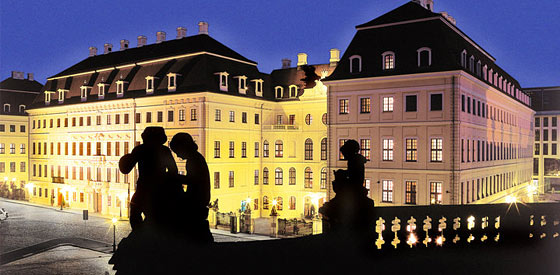
Don’t get scared off by the name of the Motel One Dresden Am Zwinger (from $93), part of a German chain—“great design for little money” is their slogan—that’s leading the European trend of budget boutique hotels. Opened earlier this year in the city center, the turquoise-accented property features small rooms that don’t feel tight thanks to smart layouts and a minimal amount of furniture. Ask for a room on the third or fifth floor for the best views of the Zwinger Palace.
Experience the bustling Neustadt (New Town) neighborhood from a quiet distance at the handsome, three-year-old Bülow Palais (from $183), located on a refined street dotted with Baroque townhouses. You’ll find antique-style wooden writing desks and rich reds and golds in its 58 rooms, as well as in the Palais Bar, where you can start Friday and Saturday evenings with live piano music at 9 p.m. before walking to bars in the lively heart of the Outer Neustadt.
Sleep inside a renovated palace at the Hotel Taschenbergpalais Kempinski (from $230), the former home of a royal mistress, which was destroyed during the World War II bombings that devastated Dresden. Rebuilt to its original grandeur, it now houses studio-apartment-sized rooms featuring modern interiors that contrast with the Baroque façade, plus prize-worthy views of the surrounding historic city center. In the winter, the interior courtyard is transformed into an ice-skating rink (free for guests).
2. Where to Eat
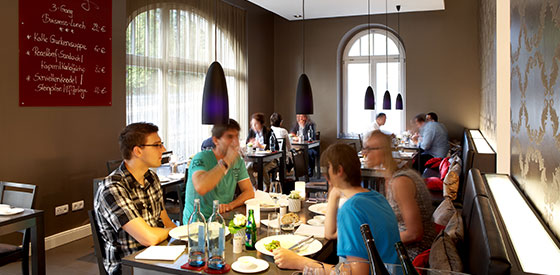
Steer clear of the kitschy, overpriced traditional German restaurants in the city center and instead head to cozy, tri-level Paul Rackwitz, a pub that’s far off the tourist trail. Settle in at a wooden, candle-lit table and fill up on classics like pork roast in red-wine sauce ($20) and beer goulash ($15), plus fusion fare including a Thai coconut curry soup ($6.50) and Indonesian-style soy-chile noodles ($14). For a cheap early dinner, take advantage of the daily prix fixe menu ($12), available between 5 and 6 p.m.
Have lunch in Outer Neustadt at colorful Lila Sosse, which sits in the Kunsthofpassage, a series of art-filled courtyards best known for its turquoise building fronted by drain pipes and gutters that make music when it rains. The traditional-with-a-twist cuisine is served in glass canning jars, like currywurst brightened by hibiscus flower ($5) and homemade spätzle with parsley pesto ($9). Order a bottle of Saxon red wine to go with it—try the velvety spätburgunder from local winery Martin Schwarz ($39/bottle).
Feast on reinterpreted German cuisine at elegant William, which opened last month at the state theater, Staatsschauspiel. Chef Stefan Hermann adds a contemporary spin to classic German cuisine: Local venison is tossed with pine nuts ($30), and baked chicken with potato-and-cucumber salad ($24) is spiced with a caper aioli. For one of the better deals in the city center, stop by for the prix fixe lunch (from $12; weekdays, 11:30 a.m.–2:30 p.m.). Chef Hermann made his name at the Michelin-starred bean&beluga, which is also worth a visit for its monthly menu of humble-meets-haute dishes like frogs’ legs, goose liver with nougat, and wild-garlic soup with honey (from $102 for three courses, with wine pairings).
3. What to Do
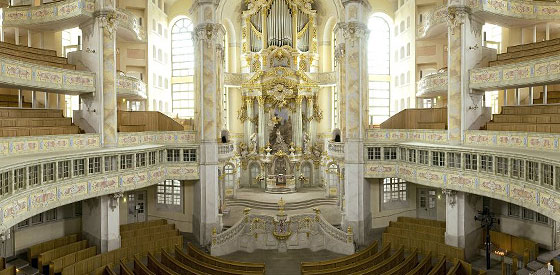
Explore Dresden’s most ambitious cultural reconstruction project, the Residenzschloss (Royal Palace; from $13 for combined museum ticket), which received its final restorative touches this year with the 2013 opening of the Riesensaal (Hall of Giants), a 7,500-square-foot hall that holds selections from one of the most important armory collections in the world. Dating back to the fourteenth century, the Royal Palace burned down during the 1945 bombing; following German reunification in the early nineties, the rebuilding efforts went into full swing, and the palace is now home to the leading State Art Collection museums. This includes the Historic Green Vault, which features nearly 3,000 treasures once owned by the rulers of the German state of Saxony, from gem-studded porcelain to the gold drinking cup of Ivan the Terrible. Tickets are timed, so be sure to reserve online when planning your trip.
Look up at the 220-foot-high sandstone dome of the Frauenkirche (Church of Our Lady), which is soaring proof of Dresden’s remarkable return to glory. The church lay in ruins for five decades after the war, but with the help of global contributions, it was rebuilt stone by stone using computer imaging, and a few old wedding photographs as a guide to reconstruct the interior. As a symbol of reconciliation, the gold cross crowning the church was made by silversmith Allen Smith, the son of a British pilot who participated in the Allied bombing of the city.
See a more contemporary edge of the city in two new additions to its landscape. Stroll the banks of the Elbe River to see the concrete-and-steel Waldschlösschen Bridge, which opened this past summer and caused a headline-grabbing showdown between the city and UNESCO, which consequently stripped the Dresden Elbe Valley of its World Heritage Status. Across the river lies Daniel Libeskind’s Bundeswehr Military History Museum (from $6.75), which opened in 2011 in a former military arsenal in the northern suburb of Albertstadt. Libeskind’s design is dominated by a five-story glittering wedge of glass and steel, the tip of which offers sweeping views of the city.
4. Insider’s Tip
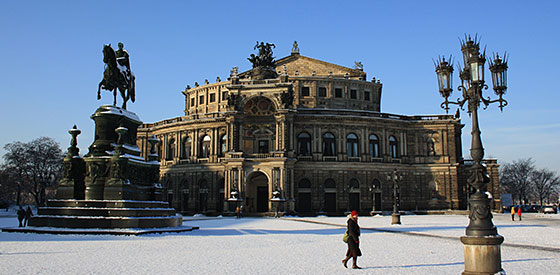
Dresden’s premier musical venue is the historic Semper Opera, which is featuring Wagner throughout 2013 to celebrate the composer’s 200th birthday. But these concerts can be pricey and difficult to reserve at the last minute; for a cheaper alternative, check out the opera’s “soirees,” which are more casual choral concerts (from $15). Semper Opera is also home to the Saxon State Orchestra, which offers regular, inexpensive chamber-music nights (from $14), and the Semperoper Ballett, where you can attend open ballet rehearsals (from $6).
5. Oddball Day
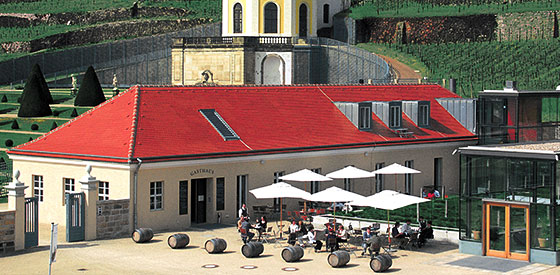
Venture out to the vineyards surrounding Dresden, which offer a mellow counterpoint to the city, especially after a glass or three of Goldriesling, a crisp varietal that’s cultivated exclusively in the region. Saxony is the smallest of Germany’s thirteen wine regions, and the majority of its bottles are consumed locally rather than exported, so this is a unique opportunity to sample and buy. Start out at the Dresden Hauptbahnhof and hop on tram 11 toward Bühlau and get off at the Elbschlösser stop to visit the Winzer Müller, a historic winery that sits on parkland in the shadow of Albrechtsberg Castle, built in 1854, which Richard Wagner used as a summer retreat. Daily tours (from $26) include a visit to the castle wine cellars and a wine-tasting stroll through vineyards against the backdrop of the old town rising over the Elbe River. Time your visit on a Sunday to enjoy a rustic lunch of flammkuchen ($6), a flatbread pizza served on a wooden board, at the winery’s outdoor wine tavern (open Sunday and holidays through November; reopens in March). Next, take tram 11 to the Bahnhof Dresden-Neustadt, and catch the S1 S-Bahn suburban train (from $7 one way) to the Radebeul East station to explore the wine town of Radebeul, which marks the center of the 55-mile Saxon Wine Route. Walk twenty minutes to the Drei Herren winery and art gallery (from $20 for a tour) to tour the cellar and sip Rieslings and other brisk white wines while browsing local art, from oversize Pollock-style splatter paintings to writhing anemone sculptures. Delve into Saxony’s impressive wine history at Schloss Wackerbarth (a ten-minute walk from the Radebeul West station), a Baroque manor house and wine estate built between 1727 and 1728 by the architect to the Imperial court. August the Strong used to throw lavish parties here and fittingly, the winery continues to produce the region’s finest sparkling wine, sekt, which is Germany’s go-to celebratory holiday drink. The winery offers a number of tours, but opt for the Sparkling Wine Tour (from $15), which includes a visit to the cellars where they still use the traditional method of riddling (turning bottles by hand). Top off the day with dinner at the stately on-site restaurant, where dishes are infused with local wines. Try gnocchi topped with a foam flavored by snappy Traminer wine ($16), cauliflower in a Riesling-spiced dough ($10), a ragout of wild mushrooms and herbs pulled from the castle garden ($18), and pork ($26) from the renowned local Saxon butcher Schempp.
6. Links
The German Wine Institute is an excellent source for information on the German wine regions, including Saxony.
Follow regional news with The Local, the German edition of Europe’s largest English-language newspaper.
Check out Lufthansa for frequent deals to Dresden, particularly now in the shoulder season.
Browse Dresden Tourism for updated information on everything from museum exhibits to concerts.